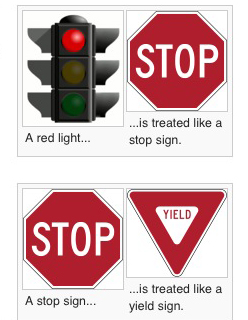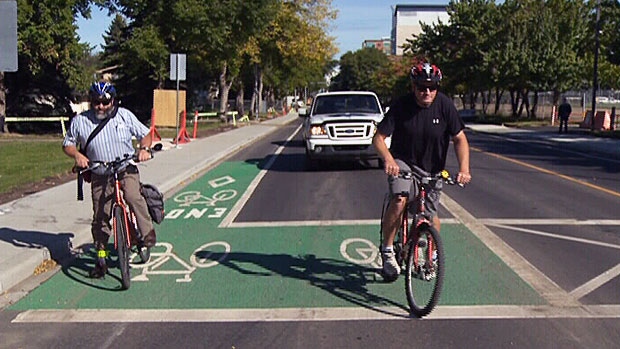This afternoon Urban Planning committee heard, and voted unanimously in favour of, the proposal to implement a minimum grid of high-quality cycling infrastructure in downtown Edmonton to be built by next summer. Of course, the motion still has to go up to council proper for approval, but it solidly seems like the votes are there.
This, however, was not the most exciting piece of news for me. That came through Ben Henderson's subsequent motion (with Don Iveson's friendly amendment)
That Administration continue to work with the Province on changes to the Highway Traffic Act to allow for Elephant's Feet and bicycle movement via Idaho stop.
This is the first time (to my recollection) that the Idaho stop has been in an Edmonton City Council motion. The Idaho Stop is something I've been incredibly passionate and supportive of for many years; it was my first email to Premier Rachel Notley when she was elected my MLA and I haven't forgotten how much I'd love to see this enshrined as law for a day since.
So what is an Idaho stop?

Simply put: The Idaho Stop allows cyclists to approach a stop sign, yield to all pedestrians and traffic in the intersection and then proceed through when it is safe and they have the right of way, without coming to a complete stop.
So, anecdotally, what all cyclists already do anyway. And it's good policy.
The Idaho Stop is safer.
When Idaho implemented this change collisions with Bicycles dropped 14%.
The Idaho Stop doesn't penalize active modes of transportation.
It's taxing for a cyclist to lose and regain all their momentum on a constant basis. It makes cycling less pleasurable, and more importantly, less viable as a commuting option when full stops have to be made every block.
The Idaho Stop allows for better flow of traffic.
Bicycles no longer have to tie up 4-way stop traffic as they slowly move through an intersection after coming to a complete stop. This improves flow in all four directions, as the slow start-up time of the bicycle delays all traffic wishing to enter the intersection.
The Idaho Stop makes traffic more predictable.
A huge source of conflict between cyclists and drivers on the road is unpredictability. What is that cyclist going to do here? Obeying every letter of the current law can make cycling taxing and feel like a punishment, so to no surprise: many cyclists disobey it (in reasonable and safe ways). That unpredictability makes things very unsafe. However, legalizing safe travel makes traffic far more predictable.
The Idaho Stop puts another nail in the coffin of Vehicular Cycling.
We know treating cyclists as vehicles with the same rights and responsibilities just doesn't work. The safest way for everyone to travel is when all modes have their own space and own regulations. Pedestrians, cyclists and vehicles should all be able to move freely and uniquely. Until we get there, however, we need to stop applying the same bludgeoning ruleset to all modes equally where it doesn't make sense. And this is a start.
Stop signs make sense for cars: they approach intersections quite quickly, they have lower visibility, and any sound is obstructed by panes of glass and engine noise. Cyclists, meanwhile, approach intersections at slower speeds, have a full field of view and have full, onobstructed stereophonic hearing. Cyclists can stop quickly when necessary. It is safe for cyclists to proceed through, after yielding.
Some drivers might say that this is unfair. Perhaps, but I think we need to grow out of the idea that the law needs to apply equally and identically to all modes of transportation. Should a cyclist ride down the centre of the lane, coming to a complete stop at every intersection? Of course not, as that would delay all traffic behind to no real benefit. The same applies to stop signs: a cyclist can yield through safely and when cycling, conservation of momentum is incredibly important! When a cyclist comes to a complete stop, it takes much longer for that cyclist to return up to their travel speed again, impeding all traffic behind him or her significantly.
Consider the following video produced in Oregon when they were debating passing an Idaho Stop law:
What about red lights? This is where most people tend to lose it, but consider for a moment: traffic planning already understands that clearing cyclists ahead of traffic before it proceeds through an intersection is an advantageous and positive strategy. It reduces conflicts and collisions in intersections. So, would it not make sense for a cyclist to come to a complete stop at a red light and, if safe, clear the way so traffic behind them can proceed. We're already planning on installing bike-phased signals in intersections downtown - cyclists treating red lights as stop signs is another logical extension of that, without additional infrastructure.
We've already installed Bike Boxes to accomplish a similar goal.

I'm confident many drivers that see cyclists cut in front of them in Bike Boxes think a law is being broken
Yes, Idaho Stopping is unfair, it doesn't treat all modes equally. But it plays to the strengths of each mode of transportation, and I can see it becoming a valuable part of ensuring that all modes get where they're going quickly and safely.
Seems like an MLA might agree.
@shawnbenbow I'm working on compiling a brief of possible cycling legislation. Idaho stop will be included.
— David Shepherd (@DShepYEG) September 28, 2016